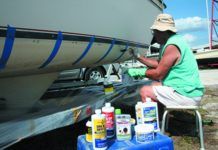Back to Diesel Revving
In a January 1 PS Advisor, the question of revving a diesel upon ending a run was addressed. I am a mechanic but not a marine diesel mechanic. So if Mike Muessel says it isn’t necessary, I am not one to disagree. But for argument’s sake, let me quote from my OEM Yanmar manual that I have from a 1989 2GM20(F) manual,pages 62, 63, that I have with my 1989 Hunter 30:
(7.4) Stopping
1- Stopping procedure
1-a) Place the clutch handle in the “neutral” position and idle the engine for about 5 minutes.
IMPORTANT: If the engine is stopped suddenly while at high temperatures, the temperature of various parts will increase. This may result in engine trouble
1-b) After five minutes’ idling, place the speed control lever in the “full” position and raise the rpms to about 3,600 to blow out any burnt gas in the cylinder.
1-c) Set the engine to the lowest speed (about 850-900 rpm), cut the fuel and stop the engine.
So it seems the reason for revving the engine after a five minute idle is to clear the cylinders of burnt fuel. Of course the manual is from 14 years ago. I perform the ritual and I don’t know many at my dock that do. After being in the automotive repair business for 27 years, I know there are as many opinions as there are mechanics.
-Douglas Miller
Raleigh, NC
We received other letters on this theme from John E. Duffy of Cedarburg, WI (quoting from the same 1989 Yanmar manual); Van Taiariol in Redwood City, CA (who was advised to rev his engine to blow water out of the water lift muffler); and John Thorpe from his Sundeer 60 (who was advised to run his engine at top speed for half an hour every month). So we sent the lot back to Mike Muessel at Oldport Marine. Here’s his reply:
“My response was based on my Yanmar schooling and many years of practical experience. In my business we run Yanmar diesels in our launches to the tune of about 1,500 hours per year per boat.We have used the 4JH series of engines for almost 20 years and have invariably gotten 9,000-12,000 hours on them before overhaul. The speed limit in Newport Harbor (RI) is 5 mph, so the enginesrarely see more than 2,000 rpm-but remember, they are under load. And we never rev them before stopping.
“We do use Purifiner bypass oil filters on all the engines. These filters keep the oil constantly clean, and we change the oil religiously-once a year! (Remember that oil doesn’t wear out, but it gets dirty.)
“Upon tear-down of a 10,000-hour engine we find the piston rings beginning to wear, and the rod bearings areworn from the constant combustion pounding they take, but the mains and crank are always within spec and the cylinders show little wear.
“I checked the latest Yanmar manuals for the GM and JH series engines and found that they recommend racing the engine 5 times after two hours of low speed operation to ‘clean out carbon from the cylinders and the fuel injection valve.’ The type of situation they are talking about-one that calls for racing the engine-is low-speed, underloaded running, such as battery charging in neutral while at anchor. Under such circumstances the engine is not working hard, and the rings can carbon-up and stick, as I mentioned in that earlier PS Advisor. This is why the book says that ‘neglecting to race the engine will result in poor exhaust color and reduce engine performance.’
“If the battery charging takes place while underway, the engine is properly loaded and the carbonization is less likely to take place. If you return to the dock or the mooring and you haven’t loaded the engine, by all means rev ‘er up. But if you’ve put the engine under load for a good amount of time and it has reached operating temperature, I wouldn’t bother.”









































